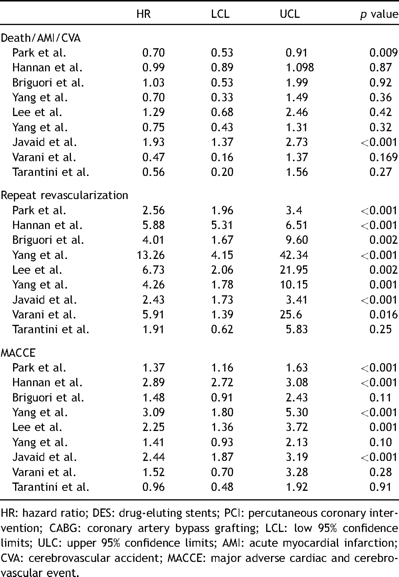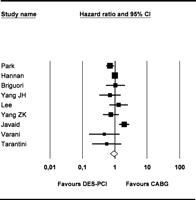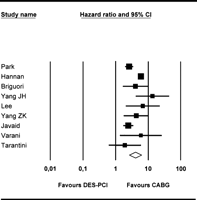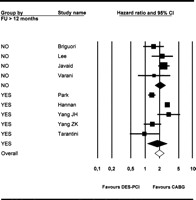-
PDF
- Split View
-
Views
-
Cite
Cite
Umberto Benedetto, Giovanni Melina, Emiliano Angeloni, Simone Refice, Antonino Roscitano, Brenno Fiorani, Gian Domenico Di Nucci, Riccardo Sinatra, Coronary artery bypass grafting versus drug-eluting stents in multivessel coronary disease. A meta-analysis on 24,268 patients, European Journal of Cardio-Thoracic Surgery, Volume 36, Issue 4, October 2009, Pages 611–615, https://doi.org/10.1016/j.ejcts.2009.03.012
Close - Share Icon Share
Abstract
Objective: Coronary artery bypass grafting (CABG) has been shown to provide better results than percutaneous coronary intervention (PCI) in multivessel coronary disease. Drug-eluting stents (DES) have significantly improved results of PCI in terms of restenosis but the advantages of such a treatment compared to CABG remain uncertain. This meta-analysis summarizes available data from observational cohorts comparing DES-PCI versus CABG. Methods: We performed a systematic literature search for observational cohorts comparing CABG versus DES-PCI in patients with multivessel coronary disease. The mixed model method was used to obtain the pooled hazard ratio (HR) for outcomes of interest. Results: A total of nine observational nonrandomized studies were identified and analyzed including a total of 24,268 patients with multivessel coronary disease who underwent DES-PCI (n = 13,540) and CABG (n = 10,728). Mean follow-up time was 20 months. Pooled analysis showed that DES-PCI and CABG were comparable in terms of composite occurrence of death, acute myocardial infarction and cerebrovascular accidents (HR = 0.94; 95% CI = 0.72–1.22; p = 0.66). However, there was a significantly higher risk of repeat revascularization in the DES-PCI group (HR = 4.06; 95% CI = 2.64–6.24; p ≪ 0.001). Overall major adverse cardiac and cerebrovascular events rate in the DES-PCI was higher compared to the CABG group (HR = 1.86; 95% CI = 1.36–2.54; p ≪ 0.001). Conclusions: In the ‘real world’ clinical practice, overall major adverse cardiac and cerebrovascular events rate continues to be higher after DES-PCI due to an excess of redo revascularization compared with CABG.
1 Introduction
The two primary interventions for patients with multivessel coronary artery disease (MVD) are coronary artery bypass grafting (CABG) and percutaneous coronary intervention (PCI).
It has been shown that there are comparable overall safety outcomes (death, acute myocardium infarction, cerebrovascular accident) in CABG and PCI patients, but repeat revascularization procedures remain higher after PCI [1,2].
The recent introduction of drug-eluting stents (DES) has further improved the results of PCI in term of restenosis thus increasing the percentage of MVD patients treated with a catheter-based approach. However the advantages of such a treatment compared to CABG remain uncertain [5–15].
Preliminary results from a single ongoing randomized controlled trial comparing DES-PCI versus CABG on a limited number of MVD patients have been recently presented [16]. As generally occurs in randomized trials, the results of this study might be subject to trial design bias by preferentially enrolling relatively low-risk patients.
Observational studies reflect the more heterogeneous ‘real world’ clinical practice and they should be considered to support the results from randomized controlled trials and therefore in determining the standard of care for MVD patients.
With the present investigation, we aimed to gain a better insight in the treatment of MVD from a meta-analysis of available observational reports comparing CABG and DES-PCI.
2 Materials and methods
The meta-analysis of Observational Studies in Epidemiology guidelines were followed. To identify studies eligible for this meta-analysis, a computerized search was performed in PubMed and Ovid databases for all English-only journals published until December 2008. All peer-reviewed retrospective observational studies that dealt with trials comparing outcomes after DES-PCI versus CABG for treatment of multivessel coronary disease were identified and reviewed. The text string employed (formatted for PubMed) was: (multivessel coronary artery disease OR multivessel coronary disease) AND (coronary artery bypass grafting OR surgical revascularization OR percutaneous coronary intervention OR drug-eluting stent OR coronary artery stenting).
Hierarchical study end points were: the composite occurrence, during follow-up, of death or acute myocardial infarction (AMI) or cerebrovascular accident (CVA); repeat revascularization; and overall major adverse cardiac and cerebrovascular events (MACCE) including death, acute myocardial infarction, cerebrovascular accident and repeat revascularization. The outcome definition used by the original researchers was accepted.
To minimize temporal bias, studies comparing DES-PCI results to historical CABG cohorts were excluded. When several articles reported on the same patient material, only the most recent article was included. Two reviewers (UB and EA) abstracted the data independently.
3 Statistical analysis
The most appropriate effect index, to evaluate time related effects of CABG and PCI was the hazard ratio (HR) and its 95% confidence limits. We assumed CABG as the gold standard and DES-PCI as the challenging strategy (HR ≪1, favors DES-PCI; HR >1, favors CABG). When only the graphed survival curves and the baseline sample sizes in the comparison groups were provided, the method of Parmar et al. [3] was used to determine the desired hazard ratio estimate and its variance. The method of Williamson et al. [4] was used to obtain the hazard ratio estimates and variances if the number of persons at risk at each of several time points for the graphed curves was available. Estimated ratios and their variances were used to construct summary 95% confidence intervals for parameters of interest for individual studies as well as for the summary measure. Publication bias was evaluated using Begg and Mazumdar rank correlation test. The mixed model method was used to account for the random variability between studies. Heterogeneity of the hazard ratios among the included studies was assessed by I2 and a value >50% was considered as indicative of heterogeneity. To assess sources of heterogeneity, subgroup analyses were performed (1): including only diabetic patients; (2) and comparing studies with shorter (12 months) versus longer follow-up (>12 months). Comprehensive Meta-Analysis, Version 2 (Borenstein and Rothstein) was used to analyze abstracted data and to generate Forrest plots for displaying the results.
4 Results
A total of nine observational nonrandomized studies [5–13] were identified and analyzed including a total of 24,268 patients with multivessel coronary disease who underwent DES-PCI (n = 13,540) and CABG (n = 10,728). They are summarized in Table 1 according to time of publication and geographical location of the study.

ERACI III [14] and ARTS II [15] studies were excluded from the analysis since the DES-PCI results were compared to historical CABG arms of ERACI II and ARTS I, respectively.
The total follow-up summed 479,524 months patients. Mean follow-up time was 20 months. The studies of Javaid et al. [5], Briguori et al. [6], Lee et al. [10], Yang et al. [11] and Varani et al. [12] have the shortest follow-up (12 months), while those of Yang et al. [9] and Park et al. [7] have the longest (25–31 months). All studies included made possible the computation of the hazard ratio for the outcomes of interest (Table 2 ).

Pooled analysis showed that DES-PCI and CABG were comparable in terms of composite occurrence of death, acute myocardial infarction and cerebrovascular accidents (HR = 0.94; 95% CI = 0.72–1.22; p = 0.66; Fig. 1 ). However, there was a significantly higher risk of repeat revascularization in the DES-PCI (HR = 4.06; 95% CI = 2.64–6.24; p ≪ 0.001; Fig. 2 ). Overall MACCE in the DES-PCI group was higher (HR = 1.86; 95% CI = 1.36–2.54; p ≪ 0.001) due to an excess of redo revascularization compared with CABG.

Pooled hazard ratio with related 95% confidence limits for the composite occurrence of death, acute myocardial infarction (AMI) and cerebrovascular accident (CVA). Squares indicate individual trial and lozenges indicate pooled summary effect estimate. The hazard ratios and its 95% confidence intervals (CI) are displayed on a logarithmic scale.

Pooled hazard ratio with related 95% confidence limits for repeat revascularization. Squares indicate individual trial and lozenges indicate pooled summary effect estimate. The hazard ratios and its 95% confidence intervals (CI) are displayed on a logarithmic scale.
There was significant heterogeneity among studies for death/AMI/CVA (I2 = 69%), repeat revascularization (I2 = 91%) and MACCE (I2 = 91%). When analysis was restricted to diabetic patients, the results did not significantly change from the overall population with regard to the composite occurrence of death/AMI/CVA (HR: 1.23; 95% CI: 0.79–1.91; p = 0.34); repeat revascularization (HR: 4.33; 95% CI: 2.68–6.98; p ≪ 0.001) and overall MACCE (HR: 2.03; 95% CI: 1.35–3.05; p = 0.001).
Pooling data from studies with shorter (12 months) versus longer (>12 months) follow-up, the estimated HRs did not significantly differ from the overall population with regard to the composite occurrence of death/AMI/CVA (HR: 1.21; p = 0.45 and HR: 0.82; p = 0.09, respectively), repeat revascularization (HR: 3.4; p ≪ 0.001 and HR: 4.2; p ≪ 0.001, respectively) and overall MACCE (HR: 2.1; p ≪ 0.001 and HR: 2.6; p ≪ 0.001, respectively, Fig. 3 ).

Pooled hazard ratio with related 95% confidence limits for major adverse cardiac and cerebrovascular events stratified for studies with shorter (12 months) versus longer (>12 months) follow-up (FU). Squares indicate individual trial, black lozenges indicate pooled summary effect estimates stratified for follow-up duration and white lozenges indicate pooled summary effect estimate. The hazard ratios and its 95% confidence intervals (CI) are displayed on a logarithmic scale.
There was no evidence of a significant publication bias for death/AMI/CVA (p = 0.10); repeat revascularization (p = 0.20) and overall MACCE (p = 0.50).
5 Discussion
The present meta-analysis showed that in the ‘real world’ clinical practice DES-PCI continues to be associated with a four-fold increased risk of repeat revascularization when compared to CABG in the treatment of MVD. Overall MACCE rate was higher in the DES-PCI group due to the excess of redo revascularization compared with CABG.
A recent meta-analysis of randomized controlled trials [2] showed that PCI with stenting was associated with a statistically significant increase in subsequent revascularization (PCI or CABG) and major adverse cardiovascular events relative to CABG.
However, these results have not been translated to recent clinical practice because of the use of bare metal stents in the PCI arms. The advent of antiproliferative drug-eluting stents has dramatically reduced restenosis and repeat revascularization thus improving the results of PCI. Whether it is time to consider PCI with DES as the preferred strategy for the treatment of MVD patients remains lack of definitive clinical evidence.
Recent comparisons between DES-PCI results and historical CABG cohorts [14,15] showed similar MACCE rates in DES-PCI and CABG treated patients, with a non-statistically significant trend towards decreased overall safety outcomes (death, AMI and CVA) in the DES-PCI group even if CABG continued to be associated with a lower rate of repeat revascularization. However these comparisons are affected by temporal bias that may reduce the strength of their conclusions.
Preliminary results from a single randomized controlled trial [16] comparing DES-PCI versus CABG on a limited number of MVD patients have been recently presented. No differences were found in the composite occurrence of death, AMI and CVA in CABG between the two groups at 12 months but overall MACCE in the DES-PCI group was significantly higher due to an excess of redo revascularization compared with CABG. As frequently occurs in randomized controlled trials, this study may result in some degree of selectability as only about 58% of patients screened for inclusion have actually been enrolled. Therefore conclusions from ongoing randomized controlled studies must be confirmed and supported by results coming from the more heterogeneous ‘real world’ clinical practice.
The present meta-analysis, summarizing results from observational studies including a large ‘real world’ MVD population, supports the conclusion that DES-PCI continues to be associated with a significantly higher risk of overall MACCE due to an excess of redo revascularization compared with CABG repeat revascularization.
Our findings need to be confirmed in ongoing, large randomized clinical trials. Finally, the present results must be interpreted with some caution since the design of studies included lack random allocation to DES-PCI or CABG.
References
Author notes
Presented at the 22nd Annual Meeting of the European Association for Cardio-thoracic Surgery, Lisbon, Portugal, September 14–17, 2008.




